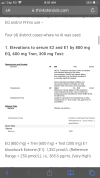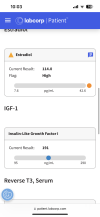So, I did some research on the supposed insensitivity of the "nonsensitive" (here, Roche ECLIA) estradiol radioimmunoassay.
From Krasowski MD, Drees D, Morris CS, Maakestad J, Blau JL, Ekins S. Cross-reactivity of steroid hormone immunoassays: clinical significance and two-dimensional molecular similarity prediction. BMC Clin Pathol. 2014 Jul 14;14:33. doi: 10.1186/1472-6890-14-33. PMID: 25071417; PMCID: PMC4112981:
 Methods
Methods
...
Two-dimensional (2D) Similarity analysis
Comparison of similarity of test molecules to the target compounds of the steroid immunoassays used two-dimensional (2D) similarity analysis, which determines the similarity between molecules independent of any in vitro data (52-54)... 2D similarity searching used the "find similar molecules by fingerprints" protocol in Discovery Studio versions 2.5.5 and 3.5 (Accelrys, Inc. San Diego, California, USA). MDL public keys (a specific 2D similarity algorithm) were used with the Tanimoto similarity coefficient (ranging from 0 to 1 with 1 being maximally similar and 0 being maximally dissimilar) as an input query...
...
Estradiol immunoassay
Only estrone (0.54%) produced greater than 0.5% cross-reactivity on the Roche Elecsys Estradiol II immunoasay at a challenge of 1 µg/mL (1,000 ng/mL) (
See Table 3). Estriol, estropipate, ethinyl estradiol, 2-methoxy-estradiol, 17β-estradiol-3, 17-disulfate each produced very weak cross-reactivity between 0.05 and 0.5%. The aromatase inhibitors exemestane (Aromasin), formestane, and letrozole produced no detectable cross-reactivity (supported also by Krasowski, M. D., Drees, D., Morris, C. S., Maakestad, J., Blau, J. L., & Ekins, S. (2014). Cross-reactivity of steroid hormone immunoassays: clinical significance and two-dimensional molecular similarity prediction. BMC Clinical Pathology, 14(1). doi:10.1186/1472-6890-14-33).
Using the cross-reactivity values, the apparent estradiol concentration that could be produced on the Roche Elecsys immunoassay was estimated for compounds based on published serum/plasma concentrations if available (see Table 3). No compound was predicted to produce estradiol concentrations within the reference range for males or females. Even estriol, which can reach high concentrations in pregnancy, likely produces little or no clinically significant impact on the Roche estradiol immunoassay due to low cross-reactivity. The 2D similarities of estrone (0.882), ethinyl estradiol (0.943), and estriol (0.917) were higher than any of the (103 structurally similar, see
3. Estradiol sheet in
Supplementary Materials workbook) compounds that were not cross-reactive on the Roche assay. See:
Supplementary Materials (1472-6890-14-33-S1.xlsx)
My understanding is that Derek from MPMD has done a YouTube video about supposed cross-reactivity of "some unknown estrogen" produced by EQ.
My conclusion is that he's pretty unreliable and his content is nothing more than entertaining.





